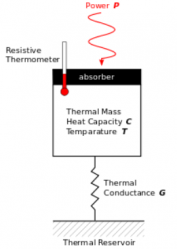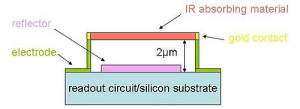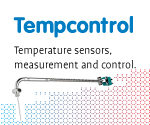Every object emits electromagnetic radiation, and the spectrum and intensity of this radiation varies mainly with temperature. The peak of the thermal radiation spectrum is typically around near infrared wavelengths. For bodies near room temperature, the peak wavelength is around 10 μm. As temperature of the body goes up, the peak wavelength decreases and the intensity of the emitted radiation increases. When an object’s temperature reaches around 800 ºC, it starts to glow red. At this point, the peak of the thermal radiation spectrum moves into the visible wavelengths. Sensing the emitted radiation of an object is the basis of contactless temperature measurement.
Bolometers (IR based)
The sensing element of a bolometer is in principle a temperature dependent resistor (RTD) material with a high thermal absorptivity. The resistance of the element can be measured just as in any other RTD.
The sensing element is positioned to face the object to be measured and radiative heat exchange between the sensing element and the object influences the element’s temperature. The thermal equilibrium reached by the element depends on its emissivity, its heat capacity and the thermal conductivity between the sensor and its housing. High emissivity, low heat capacitance and low thermal conductivity of the sensing element help to increase sensitivity and decrease response time of the sensor. Bolometers are typically sensitive to IR wavelengths between from 14 down to 8 micrometers, corresponding to roughly 250K to 400K. They are commonly used in in-ear medical thermometers.

Source: Wikipedia
Mems fabrication techniques can be used to produces arrays of very small sensing elements – microbolometers. Combined with infrared optics and readout instrumentation, microbolometers form the basis of many infrared imagers, each sensing element representing an image pixel.

Microbolometer sensing element (Source: Wikipedia)
Thermopile radiation sensors (IR based)
A thermopile sensor is similar to a bolometer, in that the temperature change of an absorptive surface is measured. However, in a thermopile sensor, the absorptive surface consists of a thin membrane on which the “hot” junctions of a thermopile are located. The thermopile (= a number of thermocouples connected in series) cold junctions are located on a more massive base. Due to its low heat capacity, the temperature of the membrane is sensitive to radiative heat influx. The temperature difference between the membrane and the sensor base creates a measureable voltage over the thermopile via the thermoelectric effect. A separate sensor on the base measures its absolute temperature.

Thermopile radiative sensor (Source: www.sensormag.com)
Optical filament pyrometers
Optical filament pyrometers (or disappearing filament pyrometers) are instruments which consist of viewing optics and a filament which is heated by an electrical current. When the object to be measured is viewed through the optics, the heated and glowing filament is seen in the foreground. The user adjusts the current through the filament until its glow “disappears” into the background. At that point the filament is the same brightness and color as the background. In other words, the filament radiates the same spectrum (in a black-body sense) as the viewed object, so the temperatures of the two objects must be the equal. The relationship between filament current and temperature is known from calibration.
And issue with this measurement technique is that the measured object may have an unknown emissivity. Often a pyrometer uses two wavelength filters. Then the ratio of the brightness of the two wavelengths can be used to determine the temperature of the object.
Other measurement techniques
Some other temperature measurement techniques are not strictly “contactless”, but do not require instrumentation in contact with the object during the measurement itself. Temperature sensitive dyes (“thermochromics”) can change color or appearance, depending on temperature. This is brought about by a change in some chemical property, which in turn influences the absorption spectrum of the dye. For example, liquid crystals can orient themselves in a spiral-like twisted configuration, the pitch of the spiral dependent on the temperature. This twisted configuration acts like a temperature sensitive grating, which reflects a certain wavelength due to constructive interference. The color of the liquid crystal is indicative of its temperature.
Other materials change appearance when transitioning from liquid to solid form, or when transitioning between other structural phases. A single such material can of course only indicate a single temperature threshold, but can do so fairly accurately. Several such materials can be used to cover a range of temperatures. “Leuco dye” is often used to produce color changing objects (i.e. mugs, t-shirts, etc). They are available for various temperature range, and typically change color of a 3 ºC range.
Still other materials change color irreversibly. This property is often used to indicate whether or not an object has ever exceeded a certain temperature, without the need for constant monitoring.
